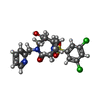[English] 日本語
 Yorodumi
Yorodumi- PDB-5obk: The Fk1 domain of FKBP51 in complex with (1S,5S,6R)-10-((3,5-dich... -
+ Open data
Open data
- Basic information
Basic information
| Entry | Database: PDB / ID: 5obk | ||||||
|---|---|---|---|---|---|---|---|
| Title | The Fk1 domain of FKBP51 in complex with (1S,5S,6R)-10-((3,5-dichlorophenyl)sulfonyl)-5-(hydroxymethyl)-3-(pyridin-2-ylmethyl)-3,10-diazabicyclo[4.3.1]decan-2-one | ||||||
 Components Components | Peptidyl-prolyl cis-trans isomerase FKBP5 | ||||||
 Keywords Keywords | ISOMERASE / Fk-506 binding domain / Hsp90 cochaperone / immunophiline / peptidyl-prolyl isomerase / ligand selectivity | ||||||
| Function / homology |  Function and homology information Function and homology informationModulation of host responses by IFN-stimulated genes / response to alcohol / FK506 binding / MECP2 regulates neuronal receptors and channels / : / heat shock protein binding / ESR-mediated signaling / HSP90 chaperone cycle for steroid hormone receptors (SHR) in the presence of ligand / response to cocaine / response to bacterium ...Modulation of host responses by IFN-stimulated genes / response to alcohol / FK506 binding / MECP2 regulates neuronal receptors and channels / : / heat shock protein binding / ESR-mediated signaling / HSP90 chaperone cycle for steroid hormone receptors (SHR) in the presence of ligand / response to cocaine / response to bacterium / peptidylprolyl isomerase / peptidyl-prolyl cis-trans isomerase activity / protein folding / protein-macromolecule adaptor activity / extracellular exosome / nucleoplasm / membrane / cytoplasm / cytosol Similarity search - Function | ||||||
| Biological species |  Homo sapiens (human) Homo sapiens (human) | ||||||
| Method |  X-RAY DIFFRACTION / X-RAY DIFFRACTION /  SYNCHROTRON / SYNCHROTRON /  MOLECULAR REPLACEMENT / Resolution: 1 Å MOLECULAR REPLACEMENT / Resolution: 1 Å | ||||||
 Authors Authors | Pomplun, S. / Sippel, C. / Haehle, A. / Bracher, A. / Hausch, F. | ||||||
 Citation Citation |  Journal: J. Med. Chem. / Year: 2018 Journal: J. Med. Chem. / Year: 2018Title: Chemogenomic Profiling of Human and Microbial FK506-Binding Proteins. Authors: Pomplun, S. / Sippel, C. / Hahle, A. / Tay, D. / Shima, K. / Klages, A. / Unal, C.M. / Riess, B. / Toh, H.T. / Hansen, G. / Yoon, H.S. / Bracher, A. / Preiser, P. / Rupp, J. / Steinert, M. / Hausch, F. #1:  Journal: ACTA CRYSTALLOGR.,SECT.D / Year: 2011 Journal: ACTA CRYSTALLOGR.,SECT.D / Year: 2011Title: Structural characterization of the PPIase domain of FKBP51, a cochaperone of human Hsp90 Authors: Bracher, A. / Kozany, C. / Thost, A.K. / Hausch, F. | ||||||
| History |
|
- Structure visualization
Structure visualization
| Structure viewer | Molecule:  Molmil Molmil Jmol/JSmol Jmol/JSmol |
|---|
- Downloads & links
Downloads & links
- Download
Download
| PDBx/mmCIF format |  5obk.cif.gz 5obk.cif.gz | 82 KB | Display |  PDBx/mmCIF format PDBx/mmCIF format |
|---|---|---|---|---|
| PDB format |  pdb5obk.ent.gz pdb5obk.ent.gz | 60.3 KB | Display |  PDB format PDB format |
| PDBx/mmJSON format |  5obk.json.gz 5obk.json.gz | Tree view |  PDBx/mmJSON format PDBx/mmJSON format | |
| Others |  Other downloads Other downloads |
-Validation report
| Summary document |  5obk_validation.pdf.gz 5obk_validation.pdf.gz | 1.2 MB | Display |  wwPDB validaton report wwPDB validaton report |
|---|---|---|---|---|
| Full document |  5obk_full_validation.pdf.gz 5obk_full_validation.pdf.gz | 1.2 MB | Display | |
| Data in XML |  5obk_validation.xml.gz 5obk_validation.xml.gz | 10.7 KB | Display | |
| Data in CIF |  5obk_validation.cif.gz 5obk_validation.cif.gz | 16.1 KB | Display | |
| Arichive directory |  https://data.pdbj.org/pub/pdb/validation_reports/ob/5obk https://data.pdbj.org/pub/pdb/validation_reports/ob/5obk ftp://data.pdbj.org/pub/pdb/validation_reports/ob/5obk ftp://data.pdbj.org/pub/pdb/validation_reports/ob/5obk | HTTPS FTP |
-Related structure data
| Related structure data |  3o5qS S: Starting model for refinement |
|---|---|
| Similar structure data |
- Links
Links
- Assembly
Assembly
| Deposited unit | 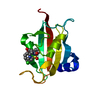
| ||||||||
|---|---|---|---|---|---|---|---|---|---|
| 1 |
| ||||||||
| Unit cell |
|
- Components
Components
| #1: Protein | Mass: 14026.077 Da / Num. of mol.: 1 / Fragment: Fk1 domain Mutation: additional N-terminal sequence GAP, cloning artefact, mutation A19T Source method: isolated from a genetically manipulated source Source: (gene. exp.)  Homo sapiens (human) / Gene: FKBP5, AIG6, FKBP51 / Plasmid: pProEx-HtB / Production host: Homo sapiens (human) / Gene: FKBP5, AIG6, FKBP51 / Plasmid: pProEx-HtB / Production host:  |
|---|---|
| #2: Chemical | ChemComp-9QN / ( |
| #3: Water | ChemComp-HOH / |
-Experimental details
-Experiment
| Experiment | Method:  X-RAY DIFFRACTION / Number of used crystals: 1 X-RAY DIFFRACTION / Number of used crystals: 1 |
|---|
- Sample preparation
Sample preparation
| Crystal | Density Matthews: 2.32 Å3/Da / Density % sol: 47.04 % / Mosaicity: 0 ° |
|---|---|
| Crystal grow | Temperature: 293 K / Method: vapor diffusion, hanging drop / pH: 7.5 Details: 30 % PEG-3350, 0.2 M NH4-acetate and 0.1 M HEPES-NaOH pH 7.5 |
-Data collection
| Diffraction | Mean temperature: 100 K | ||||||||||||||||||||||||||||||||||||||||||||||||||||||||||||||||||||||||||||||||||||||||
|---|---|---|---|---|---|---|---|---|---|---|---|---|---|---|---|---|---|---|---|---|---|---|---|---|---|---|---|---|---|---|---|---|---|---|---|---|---|---|---|---|---|---|---|---|---|---|---|---|---|---|---|---|---|---|---|---|---|---|---|---|---|---|---|---|---|---|---|---|---|---|---|---|---|---|---|---|---|---|---|---|---|---|---|---|---|---|---|---|---|
| Diffraction source | Source:  SYNCHROTRON / Site: SYNCHROTRON / Site:  ESRF ESRF  / Beamline: ID29 / Wavelength: 0.97857 Å / Beamline: ID29 / Wavelength: 0.97857 Å | ||||||||||||||||||||||||||||||||||||||||||||||||||||||||||||||||||||||||||||||||||||||||
| Detector | Type: DECTRIS PILATUS 6M / Detector: PIXEL / Date: Feb 13, 2015 | ||||||||||||||||||||||||||||||||||||||||||||||||||||||||||||||||||||||||||||||||||||||||
| Radiation | Protocol: SINGLE WAVELENGTH / Monochromatic (M) / Laue (L): M / Scattering type: x-ray | ||||||||||||||||||||||||||||||||||||||||||||||||||||||||||||||||||||||||||||||||||||||||
| Radiation wavelength | Wavelength: 0.97857 Å / Relative weight: 1 | ||||||||||||||||||||||||||||||||||||||||||||||||||||||||||||||||||||||||||||||||||||||||
| Reflection | Resolution: 0.94→39.462 Å / Num. obs: 68012 / % possible obs: 95.4 % / Redundancy: 3.9 % / Rpim(I) all: 0.021 / Rrim(I) all: 0.045 / Rsym value: 0.04 / Net I/av σ(I): 6 / Net I/σ(I): 17.6 | ||||||||||||||||||||||||||||||||||||||||||||||||||||||||||||||||||||||||||||||||||||||||
| Reflection shell | Diffraction-ID: 1
|
- Processing
Processing
| Software |
| |||||||||||||||||||||||||||||||||||||||||||||||||||||||||||||||||||||||||||
|---|---|---|---|---|---|---|---|---|---|---|---|---|---|---|---|---|---|---|---|---|---|---|---|---|---|---|---|---|---|---|---|---|---|---|---|---|---|---|---|---|---|---|---|---|---|---|---|---|---|---|---|---|---|---|---|---|---|---|---|---|---|---|---|---|---|---|---|---|---|---|---|---|---|---|---|---|
| Refinement | Method to determine structure:  MOLECULAR REPLACEMENT MOLECULAR REPLACEMENTStarting model: pdbid 3O5Q Resolution: 1→30 Å / Cor.coef. Fo:Fc: 0.983 / Cor.coef. Fo:Fc free: 0.979 / SU B: 0.534 / SU ML: 0.013 / SU R Cruickshank DPI: 0.0198 / Cross valid method: THROUGHOUT / σ(F): 0 / ESU R: 0.02 / ESU R Free: 0.02 Details: HYDROGENS HAVE BEEN ADDED IN THE RIDING POSITIONS U VALUES : REFINED INDIVIDUALLY
| |||||||||||||||||||||||||||||||||||||||||||||||||||||||||||||||||||||||||||
| Solvent computation | Ion probe radii: 0.8 Å / Shrinkage radii: 0.8 Å / VDW probe radii: 1.2 Å | |||||||||||||||||||||||||||||||||||||||||||||||||||||||||||||||||||||||||||
| Displacement parameters | Biso max: 95.55 Å2 / Biso mean: 14.554 Å2 / Biso min: 6.44 Å2
| |||||||||||||||||||||||||||||||||||||||||||||||||||||||||||||||||||||||||||
| Refinement step | Cycle: final / Resolution: 1→30 Å
| |||||||||||||||||||||||||||||||||||||||||||||||||||||||||||||||||||||||||||
| Refine LS restraints |
| |||||||||||||||||||||||||||||||||||||||||||||||||||||||||||||||||||||||||||
| LS refinement shell | Resolution: 1→1.026 Å / Rfactor Rfree error: 0 / Total num. of bins used: 20
|
 Movie
Movie Controller
Controller


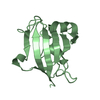
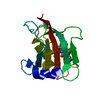
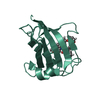
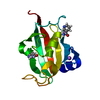

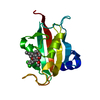
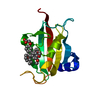
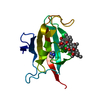
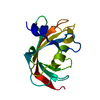
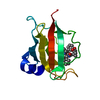
 PDBj
PDBj










